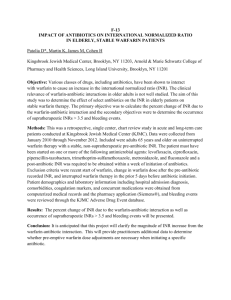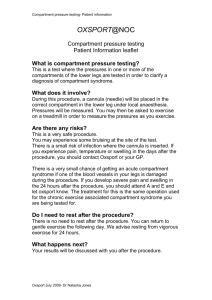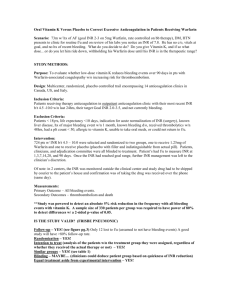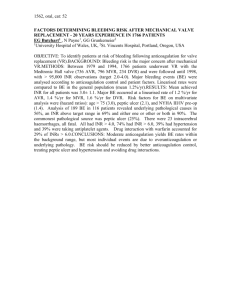Basic Information Present Illness Right Leg Swelling Present history
advertisement
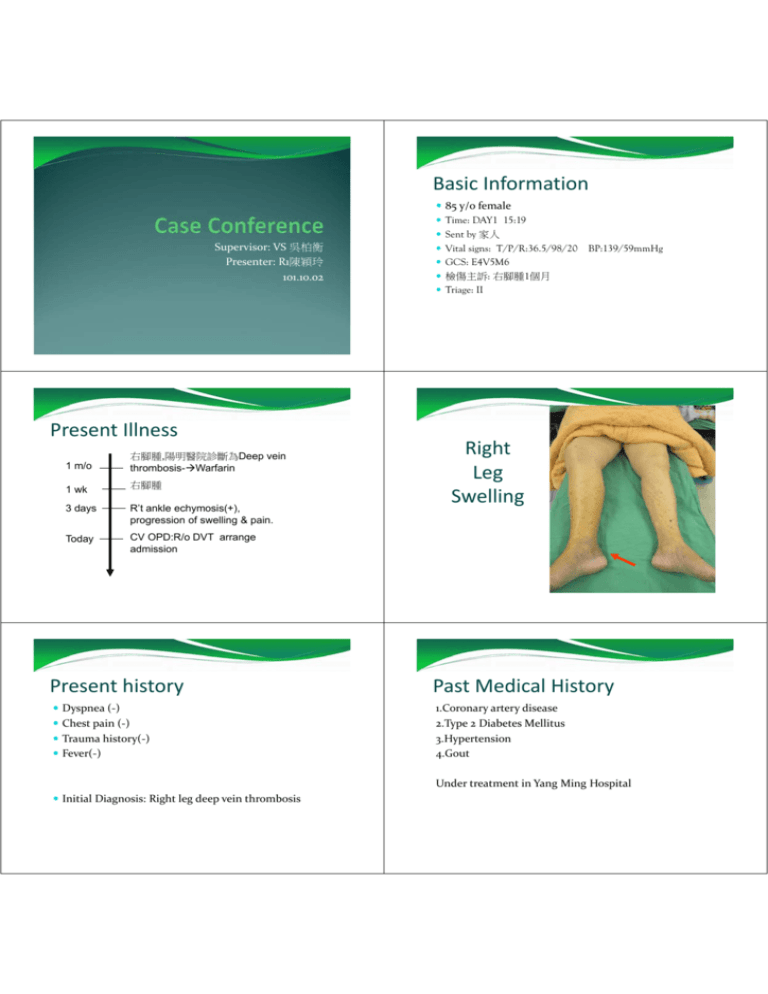
Basic Information Supervisor: VS 吳柏衡 Presenter: R1陳穎玲 101.10.02 Present Illness 1 m/o 右腳腫,陽明醫院診斷為Deep vein thrombosis-Warfarin 1 wk 右腳腫 3 days R’t ankle echymosis(+), progression of swelling & pain. Today CV OPD:R/o DVT arrange admission 85 y/o female Time: DAY1 15:19 Sent by 家人 Vital signs: T/P/R:36.5/98/20 BP:139/59mmHg GCS: E4V5M6 檢傷主訴: 右腳腫1個月 Triage: II Right Leg Swelling Present history Past Medical History Dyspnea (‐) 1.Coronary artery disease 2.Type 2 Diabetes Mellitus 3.Hypertension 4.Gout Chest pain (‐) Trauma history(‐) Fever(‐) Under treatment in Yang Ming Hospital Initial Diagnosis: Right leg deep vein thrombosis Lab Order CBC/DC Panel I PT, aPTT N/S 40cc /hr run EKG, CXR(p) Leg duplex Morphine 4mg iv st Clexane 60mg sc Q12H 排 CV admission CXR Dupplex,lower limbs EKG 16:55 DC clexane Hb,PT/APTT coming morning 轉EC 評估目前病人no active bleeding,no ecchymosis. Suggest Hold Warfarin for 1 day. EC Order PS consultation 20:55 Consult PS CK,備血 NPO Pain(+) Pulseless(-) :Dorsalis pedis artery可摸到 Numbness(-) Paralysis(-) Calf swelling,tense Suggestion: compartment syndrome cant be rule out. DAY2 Operative finding Monitor BT/HR/SpO2 Q15min Ramsay Score Q30min Coma scale/pupil size and light reflex Q30min Agonal reflex Q30min Record I/O Q1H Record suction reflex every time of suction at least Operative Note COMPARTMENT SYNDROME with coagulopathy, with muscle hematoma. Fasciotomy was done. Q2H Blood glucose Q2H EtCO2 Q6H Compartment syndrome Common site: Leg , forearm Risk Factors: 1.Trauma: Long bone fracture,burn 2.Nontraumatic cause: Ischemia-reperfusion injury,coagulopathy, certain animal bites, extravasation of IV fluids, injection of recreational drugs Uptodate: Acute compartment syndrome of the extremities Literature review current through: Aug 2012. | last updated: 三月 7, 2012. Compartment syndrome Classic signs: pain, pallor, pulselessness, paresthesias, paralysis Lab:no contributable Diagnosis Normal pressure of tissue compartment : 0 ~ 8 mmHg. ACS delta pressure = diastolic blood pressure ‒ measured compartment pressure delta pressure <20 to 30 mmHg indicates need for fasciotomy Immediate management Remove any dressing, splint, cast, Placing the limb level with the heart. Warfarin overdose treatment American Heart Assoiation Foundation to Warfarin therapy Circulation2003 Tintinalli Seven edition INR & Risk of bleeding INR>4 : increases bleeding risk INR>5: Rise sharply Approach toWarfarin overdose 1 st: Stop warfarin 2nd: Administer vitamin K 1 3rd: Administer Fresh plasma /prothrombin concentrate. Management Management 1.INR <5 , no clinically bleeding next dose omitted 3. INR > 9 ,no clinical bleeding vitamin K1, 3 to 5 mg orally, INR will fall within 24 to 48 hours. & resumed in lower dose when INR reaches theraupetic level. 2. INR : 5 ~9 ,no bleeding,no risk factors next 1 / 2 doses of warfarin omitted & resumed in lower dose when INR reaches theraupetic level. Risk factor(+) vitamin K1 (1 to 2.5 mg) orally. 4. Serious bleeding /major warfarin overdose Vit K1 intravenous infusion 10 mg + fresh plasma /prothrombin complex concentrate +/‐ Vit K1 Q12H. 5. Life‐threatening bleedingprothrombin complex concentrate replacement +iv 10 mg of vitamin K1 Use of Vitamin K1 1. Route: intravenously, subcutaneously, orally. 2. Intravenous injection :anaphylactic reactions,Warfarin resistance 3. Subcutaneous vitamin K1 :unpredictable ,sometimes delayed. Use of Vitamin K1 Oral administration is predictably effective . 2. Vitamin K1, 1 mg to 2.5 mg orally more rapidly lowers INR to 5 within 24 hours 3. INR :4 ~10 Oral vitamin K1, 1.0 to 2.5 mg INR:10 5 mg 1. Abdominal compartment syndrome due to warfarin‐related retroperitoneal hematoma A 49‐year‐old female patient was admitted to hospital complaining of progressive and severe abdominal pain for the past 3 days. She had been taking warfarin due to a prior diagnosis of deep venous trombosis of the lower extremities. Upon admission her abdomen was mildly distended, her intravesical pressure (IVP) was 45 cm H2O and her blood pressure (initially 70/40 mmHg) rose to 110/80 mmHg after rapid administration of 1000ml of saline solution. The blood count ordered upon her arrival showed a hemoglobin level of 4.1g/d, and an international normalized ratio (INR) of 4.4. CT of the abdomen and pelvis showed a large retroperitoneal and pelvic hematoma [figure 1]. Initially, a conservative approach was adopted: the patient received 1200ml of packed red cells (PRC), 1000ml of fresh frozen plasma and 3500ml of crystaloid solution. However, after the first 12 hours of observation she developed oliguria, seizures, shock and respiratory failure. Serial physical examinations revealed marked abdominal distension and IVP rose to 60cm H2O. The clinical picture resembled abdominal compartment syndrome (ACS) and a decision for decompressive laparotomy was made Clinics vol.62 no.6 São Paulo 2007 http://dx.doi.org/10.1590/S1807-59322007000600019 Compartment syndrome in upper arm in anticoagulant therapy after minor trauma Compartment syndrome can be a complication of warfarin treatment after a minor trauma. We report a case of an elderly woman who had an uncontrolled, high Internationalised Normalized Ratio (INR) level and had incurred a large haematoma on the left upper arm after a fall. After two days, the patient developed a massive oedema and clinical compartment syndrome. It is essential to be aware of symptoms and signs of compartment ischaemia, as early fasciotomy can prevent late complications such as muscle necrosis and contracture or at worst amputation. The patient should be hospitalized for observation for compartment syndrome and control of the INR level Spontaneous compartment syndrome in a patient on long‐term anticoagulation. The case is reported of a 35‐year‐old lady on long‐term anticoagulation with warfarin who developed a spontaneous acute compartment syndrome in the forearm. Despite a delay in diagnosis, an extensive decompression resulted in complete recovery. Hand Surg Br. 1993 Feb;18(1):41-2. Griffiths D, Jones DH. Ugeskr Laeger. 2010 Aug 2;172(31):2149-50. Anticoagulant‐induced intramural intestinal hematoma: report of three cases and literature review Spontaneous intestinal hematoma is a rare complication of anticoagulant therapy. The authors reported three cases of intramural and submucosal small bowel hematoma resulting from warfarin administration. The first patient presented with abdominal pain, had intramural hematoma at jejunum, the most common site of intramural small bowel hematoma. Another patient who had submucosal duodenal hematoma presented with massive upper gastrointestinal bleeding, a rare manifestation of small bowel hematoma. The third patient presented with intramural ileal hematoma that caused abdominal pain and palpable mass after a short period of warfarin therapy. Typical findings on abdominal computerized tomography yielded the diagnosis. All patients rapidly improved after conservative treatment. J Med Assoc Thai. 2008 Aug;91(8):1285-90. Take Home Message INR >4 bleeding risk ↑ Management of prolonged INR [Spontaneous intramural hematoma of the small bowel due to use of oral anticoagulants: case report and review of the literature]. We describe a case of 78 year‐old woman under anticoagulant therapy who presented abdominal pain, nausea, vomiting and an elevated prothrombin time levels (INR = 9.03). The ultrasound and abdominal CT showed a thickened small bowel wall mainly involving duodenum and jejunum. The endoscopy showed an ecchymotic aspect of duodenum and jejunum. Rev Gastroenterol Peru. 2010 Apr-Jun;30(2):158-62.
